Contamination- and Perturbation-Free Fluorescent Monitoring of Zn2+ in Suspensions Using Crown Ether-Functionalized Magnetic Nanoparticles
Abstract
:1. Introduction
2. Experimental
2.1. Materials and Instruments
2.2. Determination of Limit of Detection and Quantitation and Response Time
3. Results and Discussion
3.1. Surface Modification of Silica-Coated Magnetic Nanoparticles
3.2. Measurement Procedure
3.3. Fluorescence Response to Zn2+
3.4. Study on Reversibility and Reusability
3.5. Study on Selectivity
3.6. Study on pH Dependence
3.7. Validation by Analyzing Real Samples
4. Evaluation of the Results through Comparisons with Other Methods
5. Conclusions
Supplementary Materials
Author Contributions
Funding

Data Availability Statement
Acknowledgments
Conflicts of Interest
References
- Sarkar, K.; Dhara, K.; Nandi, M.; Roy, P.; Bhaumik, A.; Banerjee, P. Selective zinc(II)-ion fluorescence sensing by a functionalized mesoporous material covalently grafted with a fluorescent chromophore and consequent biological applications. Adv. Funct. Mater. 2009, 19, 223–234. [Google Scholar] [CrossRef]
- Dong, Z.; Dong, Z.; Wang, P.; Tian, X.; Geng, H.; Li, R.; Ma, J. A fluorescent probe for zinc detection based on organically functionalized SBA-15. Appl. Surf. Sci. 2010, 257, 802–806. [Google Scholar] [CrossRef]
- Golcs, Á.; Kovács, K.; Vezse, P.; Bezúr, L.; Huszthy, P.; Tóth, T. A cuvette-compatible Zn2+ sensing tool for conventional spectrofluorometers prepared by copolymerization of macrocyclic fluoroionophores on quartz glass surface. Methods Appl. Fluoresc. 2022, 10, 035005. [Google Scholar] [CrossRef]
- Pratiwi, F.W.; Kuo, C.W.; Chen, B.C.; Chen, P. Recent advances in the use of fluorescent nanoparticles for bioimaging. Nanomedicine 2019, 14, 1759–1769. [Google Scholar] [CrossRef] [PubMed]
- Chasapis, C.T.; Ntoupa, P.S.A.; Spiliopoulou, C.A.; Stefanidou, M.E. Recent aspects of the effects of zinc on human health. Arch. Toxicol. 2020, 94, 1443–1460. [Google Scholar] [CrossRef] [PubMed]
- Paderni, D.; Giorgi, L.; Voccia, M.; Formica, M.; Caporaso, L.; Macedi, E.; Fusi, V. A new benzoxazole-based fluorescent macrocyclic chemosensor for optical detection of Zn2+ and Cd2+. Chemosensors 2022, 10, 188. [Google Scholar] [CrossRef]
- Suh, B.; Gil, D.; Yoon, S.; Kim, K.T.; Kim, C. A practical hydrazine-carbothioamide-based fluorescent probe for the detection of Zn2+: Applications to paper strip, zebrafish and water samples. Chemosensors 2022, 10, 32. [Google Scholar] [CrossRef]
- Kim, K.T.; Yoon, S.A.; Ahn, J.; Choi, Y.; Lee, M.H.; Jung, J.H.; Park, J. Synthesis of fluorescent naphthalimide-functionalized Fe3O4 nanoparticles and their application for the selective detection of Zn2+ present in contaminated soil. Sens. Actuators B Chem. 2017, 243, 1034–1041. [Google Scholar] [CrossRef]
- World Health Organization. Zinc in Drinking-Water. Background Document for Preparation of WHO Guidelines for Drinking-Water Quality; World Health Organization: Geneva, Switzerland, 2003; Document No.: WHO/SDE/WSH/03.04/17. Available online: https://cdn.who.int/media/docs/default-source/wash-documents/wash-chemicals/zinc.pdf?sfvrsn=9529d066_4 (accessed on 18 September 2022).
- Shiller, A.M.; Boyle, E. Dissolved zinc in rivers. Nature 1985, 317, 49–52. [Google Scholar] [CrossRef]
- Zhang, S.; Han, G.; Gao, X. The urbanization impacts on potentially toxic metals: The distribution, sources and contamination risks in river situated in typical megacity, China. Sustain. Cities Soc. 2023, 97, 104784. [Google Scholar] [CrossRef]
- Sun, X.; Rosa-Gastaldo, D.; De Biasi, F.; Rastrelli, F.; Mancin, F. 1H NMR chemosensing of potassium ions enabled by guest-induced selectivity switch of a gold nanoparticle/crown ether nanoreceptor. ChemPlusChem 2019, 84, 1498–1502. [Google Scholar] [CrossRef]
- Deymehkar, E.; Taher, M.A.; Karami, C.; Arman, A. Synthesis of SPR nanosensor using gold nanoparticles and its application to copper(II) determination. Silicon 2018, 10, 1329–1336. [Google Scholar] [CrossRef]
- Kakhki, R.M.; Rakhshanipour, M. Application of nanoparticle modified with crown ether in colorimetric determinations. Arab. J. Chem. 2019, 12, 3096–3107. [Google Scholar] [CrossRef]
- Wang, C.; Sun, F.; He, G.; Zhao, H.; Tian, L.; Cheng, Y.; Li, G. Noble metal nanoparticles meet molecular cages: A tale of integration and synergy. Curr. Opin. Colloid Interface Sci. 2022, 63, 101660. [Google Scholar] [CrossRef]
- Salvia, M.V.; Salassa, G.; Rastrelli, F.; Mancin, F. Turning supramolecular receptors into chemosensors by nanoparticle-assisted “NMR chemosensing”. J. Am. Chem. Soc. 2015, 137, 11399–11406. [Google Scholar] [CrossRef] [PubMed]
- Müller, B.J.; Zhdanov, A.V.; Borisov, S.M.; Foley, T.; Okkelman, I.A.; Tsytsarev, V.; Tang, Q.; Erzurumlu, R.S.; Chen, Y.; Zhang, H.; et al. Nanoparticle-based fluoroionophore for analysis of potassium ion dynamics in 3D tissue models and in vivo. Adv. Funct. Mater. 2018, 28, 1704598. [Google Scholar] [CrossRef] [PubMed]
- Bakker, E.; Bühlmann, P.; Pretsch, E. Carrier-based ion-selective electrodes and bulk optodes. 1. General characteristics. Chem. Rev. 1997, 97, 3083–3132. [Google Scholar] [CrossRef]
- Geißler, D.; Nirmalananthan-Budau, N.; Scholtz, L.; Tavernaro, I.; Resch-Genger, U. Analyzing the surface of functional nanomaterials—How to quantify the total and derivatizable number of functional groups and ligands. Mikrochim. Acta 2021, 188, 321. [Google Scholar] [CrossRef] [PubMed]
- Lakatos, S.; Fetter, J.; Bertha, F.; Huszthy, P.; Tóth, T.; Farkas, V.; Orosz, G.; Hollósi, M. Preparation of a new chiral acridino-18-crown-6 ether-based stationary phase for enantioseparation of racemic protonated primary aralkyl amines. Tetrahedron 2008, 64, 1012–1022. [Google Scholar] [CrossRef]
- Kobayashi, Y.; Gu, S.; Nagao, D.; Konno, M. Direct coating of particles by a liquid phase process. Curr. Nanosci. 2007, 3, 222–240. [Google Scholar] [CrossRef]
- Kumar, S.; Ten Siethoff, L.; Persson, M.; Albet-Torres, N.; Månsson, A. Magnetic capture from blood rescues molecular motor function in diagnostic nanodevices. J. Nanobiotechnol. 2013, 11, 14. [Google Scholar] [CrossRef] [PubMed]
- Zlateski, V.; Fuhrer, R.; Koehler, F.M.; Wharry, S.; Zeltner, M.; Stark, W.J.; Moody, T.S.; Grass, R.N. Efficient magnetic recycling of covalently attached enzymes on carbon-coated metallic nanomagnets. Bioconjug. Chem. 2014, 25, 677–684. [Google Scholar] [CrossRef] [PubMed]
- Herrmann, I.K.; Schlegel, A.; Graf, R.; Schumacher, C.M.; Senn, N.; Hasler, M.; Gschwind, S.; Hirt, A.-M.; Günther, D.; Clavien, P.-A.; et al. Nanomagnet-based removal of lead and digoxin from living rats. Nanoscale 2013, 5, 8718–8723. [Google Scholar] [CrossRef] [PubMed]
- Sá, J.; Szlachetko, J.; Sikora, M.; Kavčič, M.; Safonova, O.V.; Nachtegaal, M. Magnetic manipulation of molecules on a non-magnetic catalytic surface. Nanoscale 2013, 5, 8462–8465. [Google Scholar] [CrossRef] [PubMed]
- Kainz, Q.M.; Zeltner, M.; Rossier, M.; Stark, W.J.; Reiser, O. Synthesis of trisubstituted ureas by a multistep sequence utilizing recyclable magnetic reagents and scavengers. Chem. Eur. J. 2013, 19, 10038–10045. [Google Scholar] [CrossRef] [PubMed]
- Kawasaki, H.; Nakai, K.; Arakawa, R.; Athanassiou, E.K.; Grass, R.N.; Stark, W.J. Functionalized graphene-coated cobalt nanoparticles for highly efficient surface-assisted laser desorption/ionization mass spectrometry analysis. Anal. Chem. 2012, 84, 9268–9275. [Google Scholar] [CrossRef] [PubMed]
- Wang, F.; Wang, K.; Kong, Q.; Wang, J.; Xi, D.; Gu, B.; Lu, S.; Wei, T.; Chen, X. Recent studies focusing on the development of fluorescence probes for zinc ion. Coord. Chem. Rev. 2021, 429, 213636. [Google Scholar] [CrossRef]
- Sadananda, D.; Mallikarjunaswamy, A.M.M.; Prashantha, C.N.; Mala, R.; Gouthami, K.; Lakshminarayana, L.; Ferreira, L.F.R.; Bilal, M.; Rahdar, A.; Mulla, S.I. Recent development in chemosensor probes for the detection and imaging of zinc ions: A systematic review. Chem. Pap. 2022, 76, 5997–6015. [Google Scholar] [CrossRef]
- Li, D.; Ma, Y.; Duan, H.; Jiang, F.; Deng, W.; Ren, X. Fluorescent/SERS dual-sensing and imaging of intracellular Zn2+. Anal. Chim. Acta 2018, 1038, 148–156. [Google Scholar] [CrossRef]
- Jia, M.Y.; Wang, Y.; Liu, Y.; Niu, L.Y.; Feng, L. BODIPY-based self-assembled nanoparticles as fluorescence turn-on sensor for the selective detection of zinc in human hair. Biosens. Bioelectron. 2016, 85, 515–521. [Google Scholar] [CrossRef]
- Wu, Q.; Zhou, M.; Shi, J.; Li, Q.; Yang, M.; Zhang, Z. Synthesis of water-soluble Ag2S quantum dots with fluorescence in the second near-infrared window for turn-on detection of Zn(II) and Cd(II). Anal. Chem. 2017, 89, 6616–6623. [Google Scholar] [CrossRef]
- Pourfallah, G.; Lou, X. Novel 4-amino-2-methyl-8-(trifluoromethyl)quinoline-based magnetic nanostructures for highly sensitive detection of zinc ions in aqueous solutions. Dyes Pigm. 2018, 158, 12–19. [Google Scholar] [CrossRef]
- Shen, W.; Li, Y.; Qi, T.; Wang, S.; Sun, J.; Deng, H.; Lu, H.; Chen, C.; Chen, L.; Tang, S. Fluorometric determination of zinc(II) by using DNAzyme-modified magnetic microbeads. Microchim. Acta 2018, 185, 447. [Google Scholar] [CrossRef]
- Golcs, Á.; Kovács, K.; Vezse, P.; Tóth, T.; Huszthy, P. Acridino-diaza-20-crown-6 ethers: New macrocyclic hosts for optochemical metal ion sensing. Molecules 2021, 26, 4043. [Google Scholar] [CrossRef] [PubMed]
- Long, G.L.; Winefordner, J.D. Limit of detection. A closer look at the IUPAC definition. Anal. Chem. 1983, 55, 712A–724A. [Google Scholar]
- Lee, H.N.; Kim, H.N.; Swamy, K.M.K.; Park, M.S.; Kim, J.; Lee, H.; Park, S.; Yoon, J. New acridine derivatives bearing immobilized azacrown or azathiacrown ligand as fluorescent chemosensors for Hg2+ and Cd2+. Tetrahedron Lett. 2008, 49, 1261–1265. [Google Scholar] [CrossRef]
- dos Santos Carlos, F.; da Silva, L.A.; Zanlorenzi, C.; Nunes, F.S. A novel macrocycle acridine-based fluorescent chemosensor for selective detection of Cd2+ in Brazilian sugarcane spirit and tobacco cigarette smoke extract. Inorg. Chim. Acta 2020, 508, 119634–119641. [Google Scholar] [CrossRef]
- Visscher, A.; Bachmann, S.; Schnegelsberg, C.; Teuteberg, T.; Mata, R.A.; Stalke, D. Highly selective and sensitive fluorescence detection of Zn2+ and Cd2+ ions by using an acridine sensor. Dalton Trans. 2016, 45, 5689–5699. [Google Scholar] [CrossRef] [PubMed]
- Wang, Y.; Hu, X.; Wang, L.; Shang, Z.; Chao, J.; Jin, W. A new acridine derivative as a highly selective ‘off–on’ fluorescence chemosensor for Cd2+ in aqueous media. Sens. Actuators B Chem. 2011, 156, 126–131. [Google Scholar] [CrossRef]
- Wang, C.; Fu, J.; Yao, K.; Xue, K.; Xu, K.; Pang, X. Acridine-based fluorescence chemosensors for selective sensing of Fe3+ and Ni2+ ions. Spectrochim. Acta A 2018, 199, 403–411. [Google Scholar] [CrossRef] [PubMed]
- Zhou, J.; Yuan, Y.F.; Zhuo, J.B.; Lin, C.X. Synthesis and characterization of cyclophane: The highly selective recognition of Fe3+ in aqueous solution and H2PO4− in acetonitrile solution. Tetrahedron Lett. 2018, 59, 1059–1064. [Google Scholar] [CrossRef]
- Saravanan, A.; Shyamsivappan, S.; Suresh, T.; Subashini, G.; Kadirvelu, K.; Bhuvanesh, N.; Nandhakumar, R.; Mohan, P.S. An efficient new dual fluorescent pyrene based chemosensor for the detection of bismuth(III) and aluminium(III) ions and its applications in bio-imaging. Talanta 2019, 198, 249–256. [Google Scholar] [CrossRef] [PubMed]
- El-Sewify, I.M.; Shenashen, M.A.; Shahat, A.; Yamaguchi, H.; Selim, M.M.; Khalil, M.M.; El-Safty, S.A. Dual colorimetric and fluorometric monitoring of Bi3+ ions in water using supermicroporous Zr-MOFs chemosensors. J. Lumin. 2018, 198, 438–448. [Google Scholar] [CrossRef]
- Ramasamy, K.; Thambusamy, S. Dual emission and pH based naphthalimide derivative fluorescent sensor for the detection of Bi3+. Sens. Actuators B Chem. 2017, 247, 632–640. [Google Scholar] [CrossRef]
- Zhang, E.; Ju, P.; Li, Q.; Hou, X.; Yang, H.; Yang, X.; Zou, Y.; Zhang, Y. A novel rhodamine 6G-based fluorescent and colorimetric probe for Bi3+: Synthesis, selectivity, sensitivity and potential applications. Sens. Actuators B Chem. 2018, 260, 204–212. [Google Scholar] [CrossRef]
- Yue, X.L.; Wang, Z.Q.; Li, C.R.; Yang, Z.Y. Naphthalene-derived Al3+-selective fluorescent chemosensor based on PET and ESIPT in aqueous solution. Tetrahedron Lett. 2017, 58, 4532–4537. [Google Scholar] [CrossRef]
- Yu, C.; Jian, L.; Ji, Y.; Zhang, J. Al(III)-responsive “off-on” chemosensor based on rhodamine derivative and its application in cell imaging. RSC Adv. 2018, 8, 31106–31112. [Google Scholar] [CrossRef] [PubMed]
- Qiu, L.; Zhou, S.; Li, Y.; Rui, W.; Cui, P.; Zhang, C.; Yu, Y.; Wang, C.; Wang, X.; Wang, J.; et al. Silica-coated Fe3O4 nanoparticles as a bifunctional agent for magnetic resonance imaging and ZnII fluorescent sensing. Technol. Cancer Res. Treat. 2021, 20, 3667–3673. [Google Scholar] [CrossRef]
- Yang, M.; Kong, W.; Li, H.; Liu, J.; Huang, H.; Liu, Y.; Kang, Z. Fluorescent carbon dots for sensitive determination and intracellular imaging of zinc(II) ion. Microchim. Acta 2015, 182, 2443–2450. [Google Scholar] [CrossRef]
- Xu, S.; Zhang, L.; Zhao, Y.; Luo, Y.; Yu, B.; Zhang, W. A magnetic functionalized lanthanide fluorescent sensor for detection of trace zinc ion. Res. Chem. Intermed. 2021, 47, 3487–3500. [Google Scholar] [CrossRef]
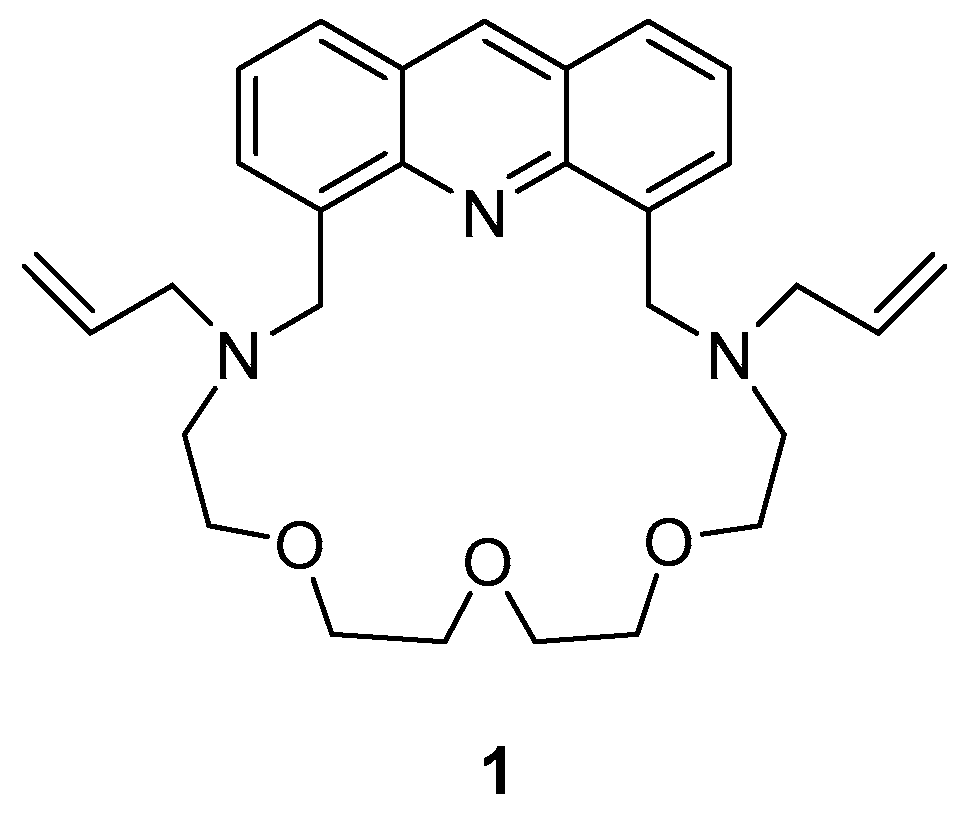
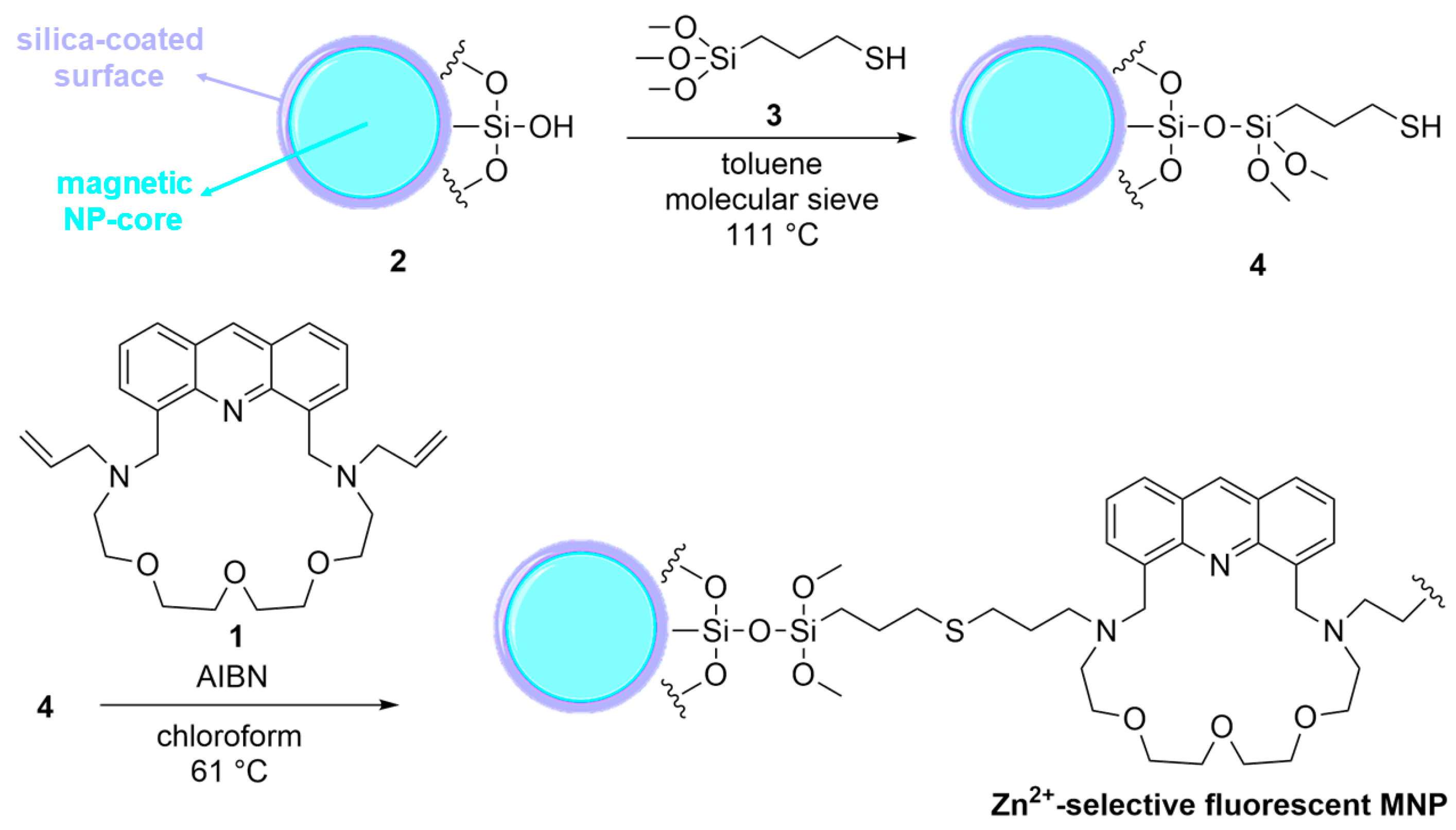
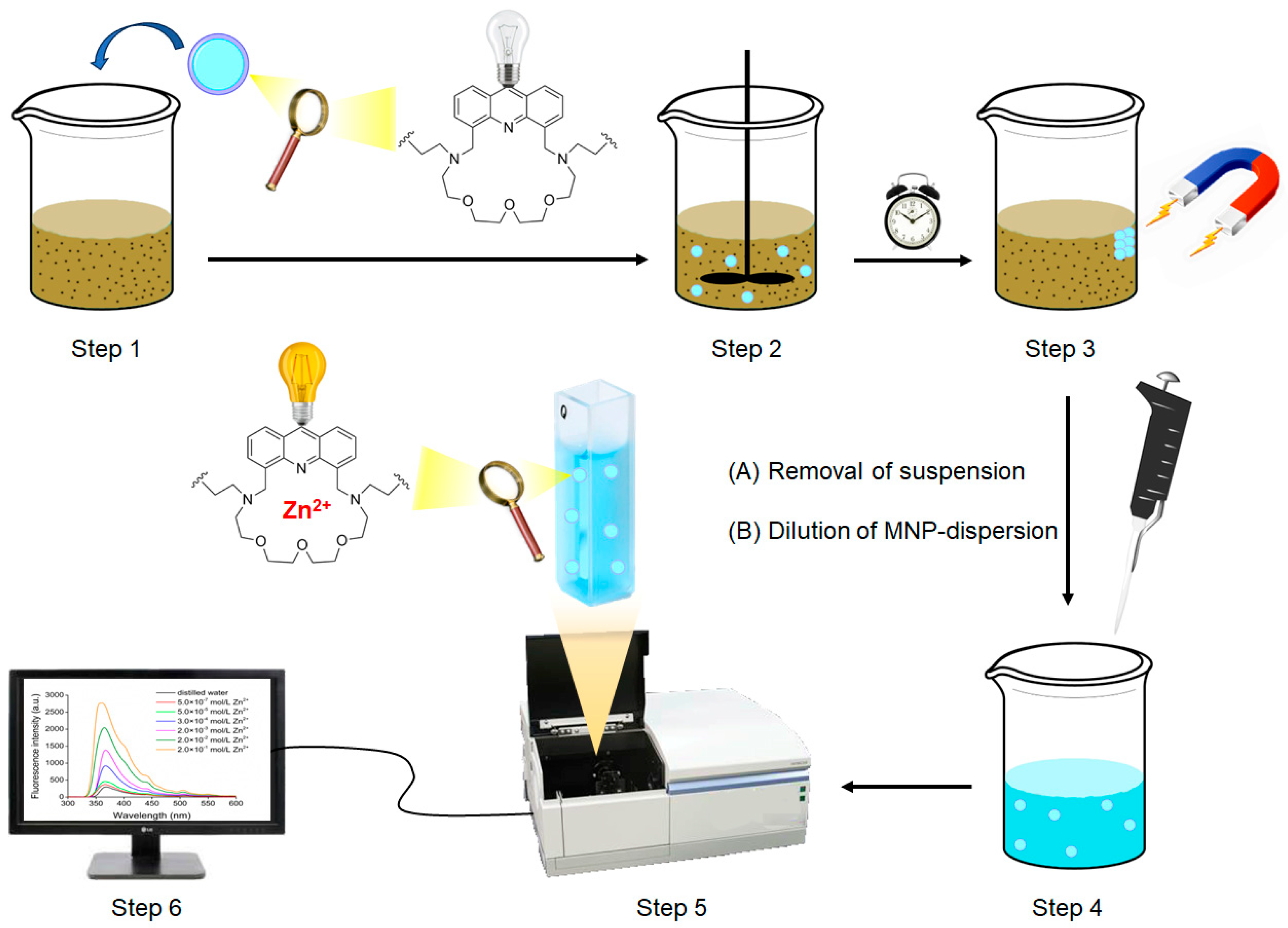


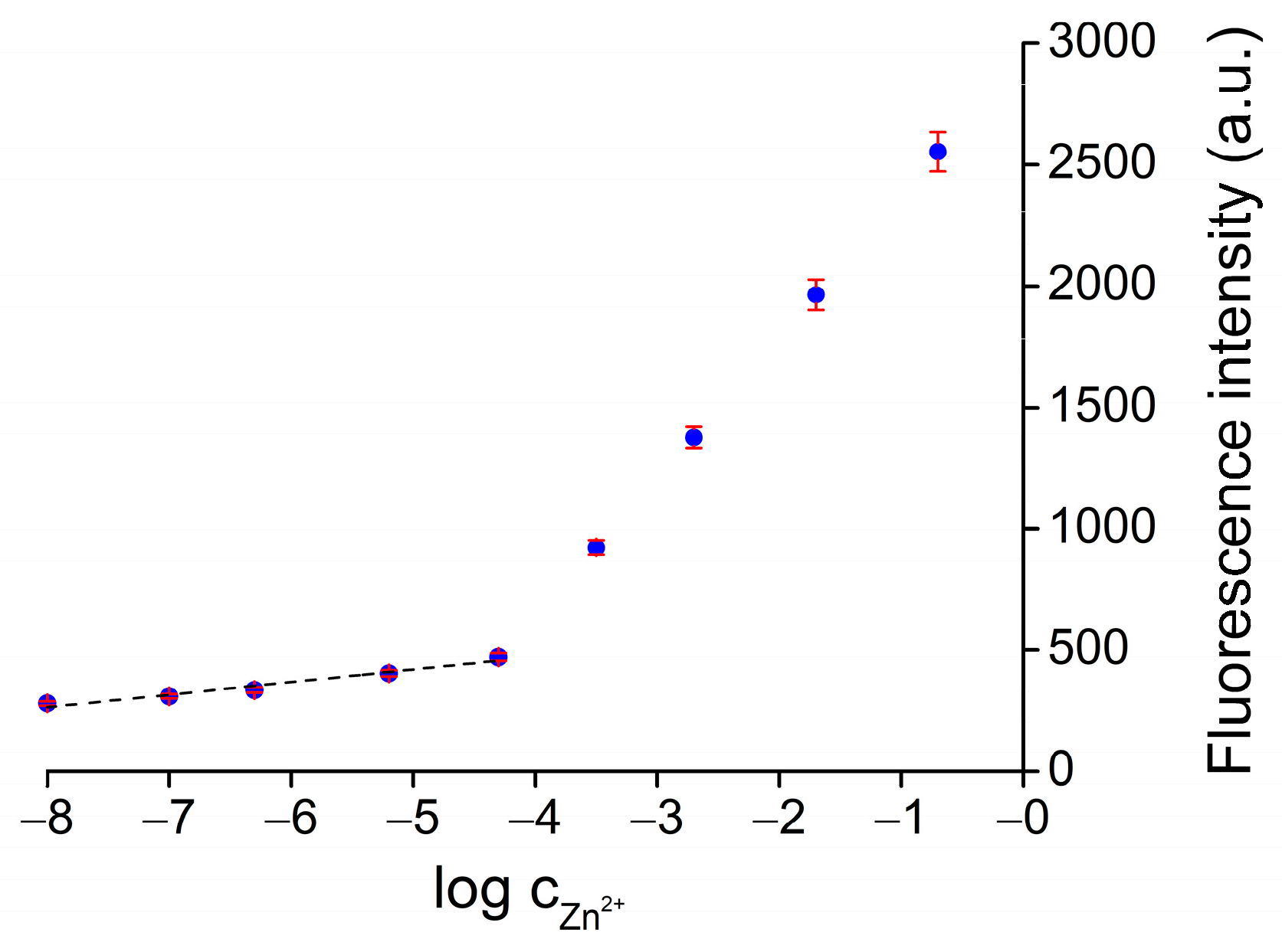
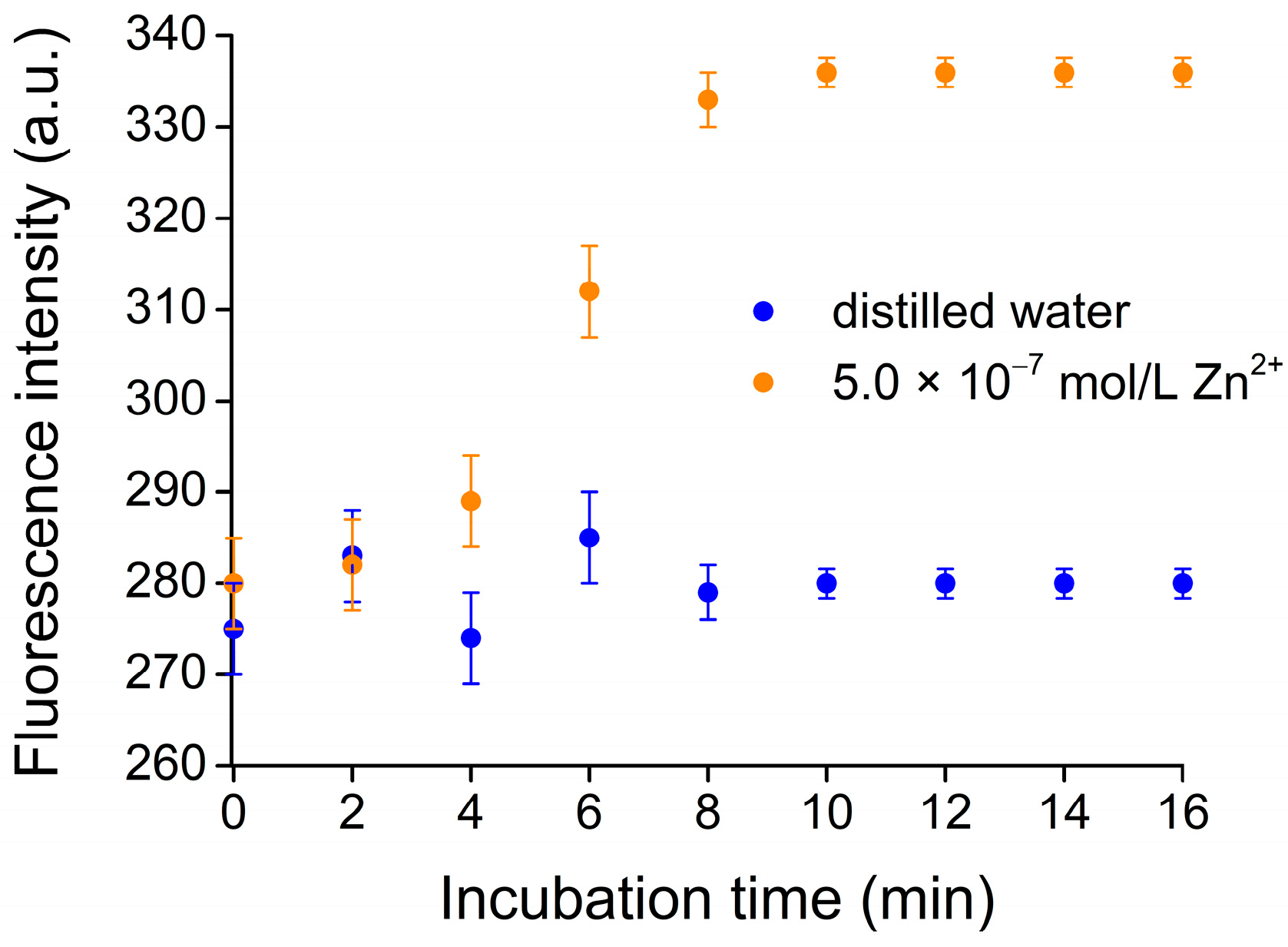


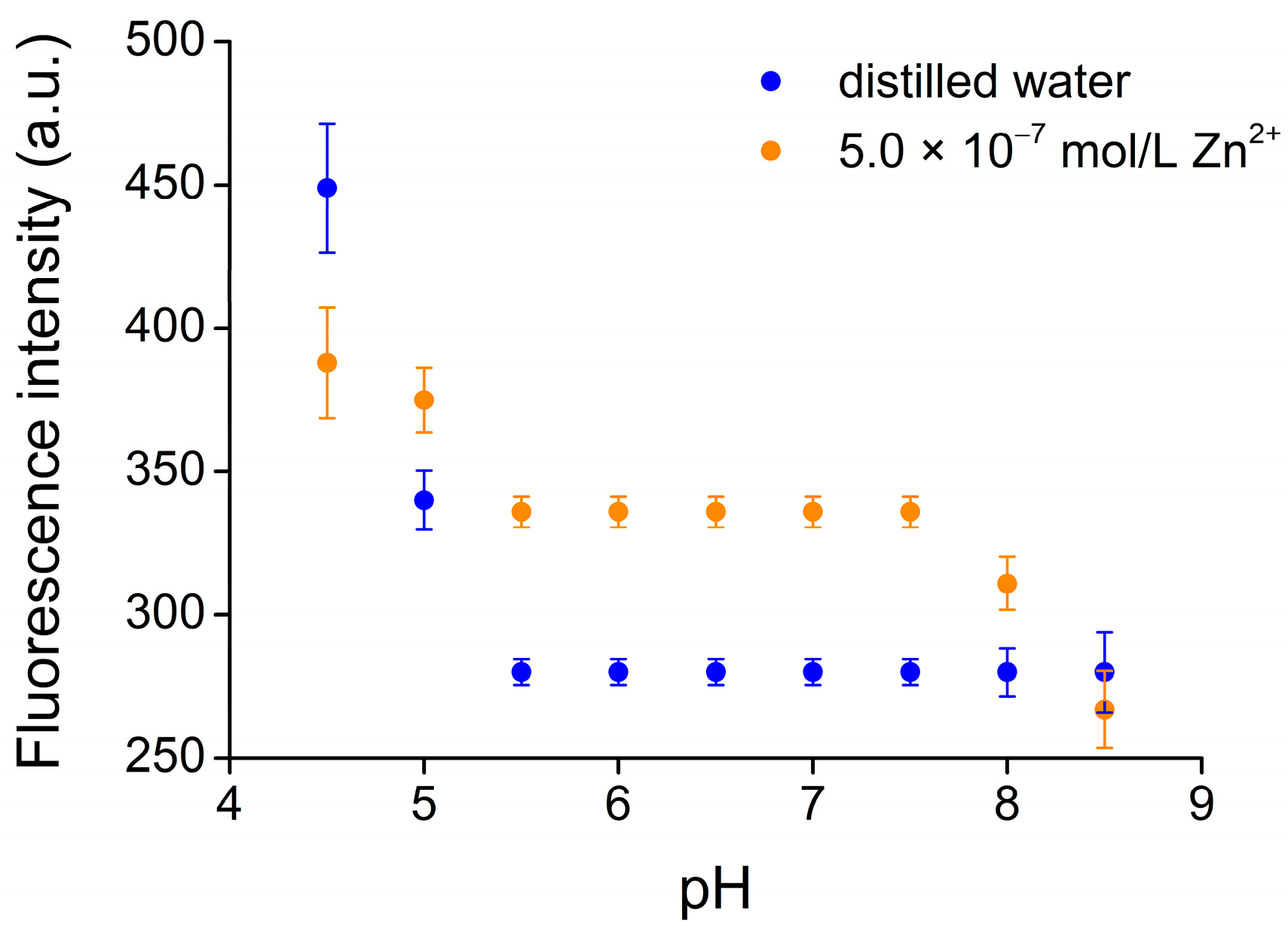
| River Water | Aqueous Suspension of Pumpkin Seed Flour | |
|---|---|---|
| 1 | 50 ppb | 105 ppb |
| 2 | 358 | 375 |
| 344 | 352 | |
| 3 | 27 ± 8 ppb | 39 ± 11 ppb |
| NP Type | Magnetic Property (✓ or ✗) 1 | LOD (ppb) | Linear Range of Optical Response (ppb) | Reference |
|---|---|---|---|---|
| Fe3O4 nanomagnet functionalized with dopamine-naphthalimide-dipicolylamine | ✓ | 3.5 × 10−2 | 0–1308 | [8] |
| N-(2-(bis(pyridine-2-ylmethyl)amino)ethyl)-2-mercaptoacetamide modified gold NP | ✗ | 1.8 × 10−5 | 65–7848 | [30] |
| BODIPY-based self-assembled NPs | ✗ | 4 | 65–654 | [31] |
| Water-soluble Ag2S quantum dots | ✗ | 50 | 50–2616 | [32] |
| 4-Amino-2-methyl-8-(trifluoromethyl)quinoline functionalized silica-coated Fe3O4 nanomagnet | ✓ | 0.4 | not reported | [33] |
| DNAzyme-modified magnetic microbeads | ✓ | 2.2 × 10−6 | 6.5 × 10−6–0.72 | [34] |
| 8-Amimoquinoline(N-(quinolin-8-yl)-2-(3-(triethoxysilyl) propylamino)acetamide) functionalized silica-coated Fe3O4 nanomagnet | ✓ | not reported | not reported | [49] |
| Carbon dots from glucose combined with non-bounded fluorogenic quercetin | ✗ | 131 | 131–6540 | [50] |
| Magnetic functionalized terbium coordination polymer-adsorbent | ✓ | 14 | 14–10,464 | [51] |
| Commercially available silica-coated TurboBeadsTM functionalized with fluorogenic crown ether | ✓ | 5 | 15–3000 | present work |
Disclaimer/Publisher’s Note: The statements, opinions and data contained in all publications are solely those of the individual author(s) and contributor(s) and not of MDPI and/or the editor(s). MDPI and/or the editor(s) disclaim responsibility for any injury to people or property resulting from any ideas, methods, instructions or products referred to in the content. |
© 2023 by the authors. Licensee MDPI, Basel, Switzerland. This article is an open access article distributed under the terms and conditions of the Creative Commons Attribution (CC BY) license (https://creativecommons.org/licenses/by/4.0/).
Share and Cite
Vezse, P.; Golcs, Á.; Tóth, T.; Huszthy, P. Contamination- and Perturbation-Free Fluorescent Monitoring of Zn2+ in Suspensions Using Crown Ether-Functionalized Magnetic Nanoparticles. Chemosensors 2023, 11, 547. https://doi.org/10.3390/chemosensors11100547
Vezse P, Golcs Á, Tóth T, Huszthy P. Contamination- and Perturbation-Free Fluorescent Monitoring of Zn2+ in Suspensions Using Crown Ether-Functionalized Magnetic Nanoparticles. Chemosensors. 2023; 11(10):547. https://doi.org/10.3390/chemosensors11100547
Chicago/Turabian StyleVezse, Panna, Ádám Golcs, Tünde Tóth, and Péter Huszthy. 2023. "Contamination- and Perturbation-Free Fluorescent Monitoring of Zn2+ in Suspensions Using Crown Ether-Functionalized Magnetic Nanoparticles" Chemosensors 11, no. 10: 547. https://doi.org/10.3390/chemosensors11100547
APA StyleVezse, P., Golcs, Á., Tóth, T., & Huszthy, P. (2023). Contamination- and Perturbation-Free Fluorescent Monitoring of Zn2+ in Suspensions Using Crown Ether-Functionalized Magnetic Nanoparticles. Chemosensors, 11(10), 547. https://doi.org/10.3390/chemosensors11100547









